May 31, 2025 | 17:52 GMT +7
May 31, 2025 | 17:52 GMT +7
Hotline: 0913.378.918
May 31, 2025 | 17:52 GMT +7
Hotline: 0913.378.918
Pig farming in Vietnam accounts for a large proportion of the structure of the livestock industry in particular and agriculture in general. Investment in pig farming (scale, technology, etc.) recently also accounts for a proportionally high proportion and is much higher than in other livestock industries.
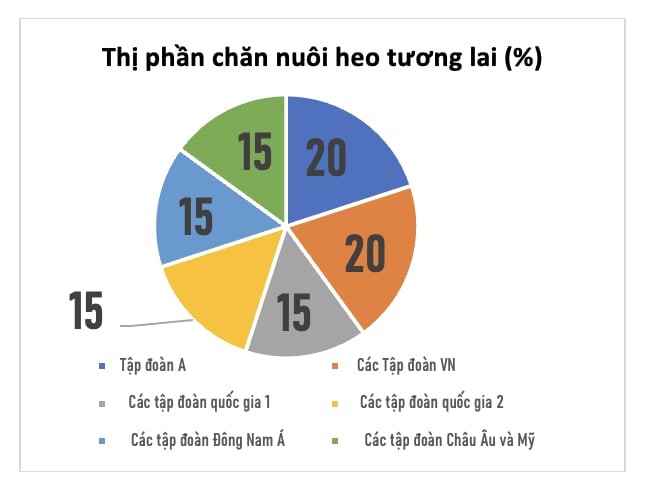
In the future, if a corporation holds 20% of the pig farming market share, along with cooperation and consolidation according to groups of countries or strategic partners, there may not be much space left for pig farming according to farmer households. It means that farmer households have to rent, process, or close barns, or change to other exploitation or use purposes. This is similar to the model of developed countries and the trend of developing large livestock models and projects that have been implemented or operated in recent years, especially in some North Central, Central Highlands, and Southeast provinces and cities. This trend may shift or develop in some Southwest provinces in the next decade.
It can be seen that pig farming has undergone a major transformation and will make a big breakthrough in the second livestock industrial revolution starting in the early 2020s (the first in the 1990s). Vietnam currently ranks fifth in the world in terms of pig population.
Within the scope of this article, new technology is understood as old technology but still effectively applied in Vietnam without newer technology, or it is completely new technology; and some trends and technologies in seeds, feed, barns, and solid waste treatment will be the focus of discussion.
In fact, recent new technologies are limited and encapsulated in the “precision” word. That also means that previous technologies were not inaccurate but not completely accurate, so today's new technologies are gradually moving towards more accurate levels.
Seeds account for 2–6% of production costs but contribute up to 40% to productivity and efficiency. Current breeding is based on the basic foundation of classical genetics (quantity and population—BLUP method) combined with modern genetics (molecular—MAS, next-generation sequencing or gene editing, QTLs, etc.). Breeding tends to focus on quality, ensuring consumer health and disease resistance to increase environmental resistance and minimize antibiotic use during the farming process.

Contribution of classical and modern genetics to seed value.
Basically, genetic improvement still relies on the large contribution of classical genetics. Data on purebred lines, seed/pedigree levels, and other information channels (slaughterhouses, meet seed and breeding seed buyers) are all recorded, linked, and analyzed according to traditional models. However, recently, genetic technologies have had a big breakthrough, creating disease-resistant varieties (for example, a pig variety resistant to E.Coli F18 and soon a PRRS-resistant variety editing the CD163 gene to prevent virus intrusion). This helps genetic selection and improvement work be carried out faster while increasing precision, effectiveness, and optimization of selection.

Breeding pigs resistant to “Blue Ear Pig” disease (PRRS) through gene-editing technology (https://doi.org/10.3389/fmicb.2022.1006464).
Feed technology targets biological or natural raw materials (probiotics, prebiotics, organic acids, herbs, antioxidants, etc.) using microbiology, fermentation, pharmaceutical extraction, microencapsulation technologies, etc. to replace or minimize the use of antibiotics, growth stimulants, etc. Thereby helping livestock increase resistance, enhance biological value, digestion, and absorption, and protecting consumers' health.

Dry and liquid feed mixing technology is also established, ensuring good quality control. Feed is stored in independent silos managed by software. (https://doi.org/10.3390/ani11102983).
The feed formula has been detailed for each micronutrient (vitamins, amino acids, absorbed micronutrients, etc.) for each livestock object, combined with a precision feeding system (by group, individual, productivity, etc.) and the use of chip technology, automation, and other technologies to help identify individuals, create conditions for individuals to consume easily absorbed food, and optimize the productivity of each individual.
Investors often pay attention to building or investing in barn technology based on natural characteristics, regional climate, and livestock objects to optimize costs (investment, management, operation, etc.) and strictly manage (herd, bran, etc.) while improving animal welfare—one of the mandatory requirements for calling for foreign capital and export. However, no matter what technology it is, it must be easy to operate and operate safely (labor and biosafety), easy to maintain or troubleshoot simple problems, and ensure smooth production.

Multi-technology integrated barn system (www.skov.com).
The new technologies introduced into barn design are quite diverse and sophisticated. It is a multi-technology integration (automation, AI, robot, camera, etc.). A modern barn can: (i) control or filter incoming air, including many types of viruses; (ii) regulate microclimate, humidity, and multi-dimensional ventilation (which helps pigs have good health, consume a lot of food, and grow rapidly); (iii) have an alarm system, an emergency opening, and mechanical ventilation when power fails; (iv) have software (cloud computing, real-time data, data analysis), (v) identify individuals, weigh or count pigs, or detect sick-fever pigs using cameras, (vi) Clean the air of the farming barn (gas emissions, pathogens, dust) using meters, air distribution plates, system-cleaning robot; (vii) manage the quantity and quality of food and drink.
Waste treatment, especially organic solid waste, is currently the biggest concern for livestock farmers. The complete construction of a waste treatment system requires (i) complying with standards and regulations on the livestock environment (biosafety, limiting sources of infection and odors, etc.); (ii) optimizing investment costs; (iii) converting waste into more valuable resources and raw materials; and (iv) building an environmentally friendly livestock ecosystem, a circular economy, and sustainable development. There are many waste treatment technologies, but in general, the model below is still widely and effectively applied in the current livestock farming conditions in Vietnam.
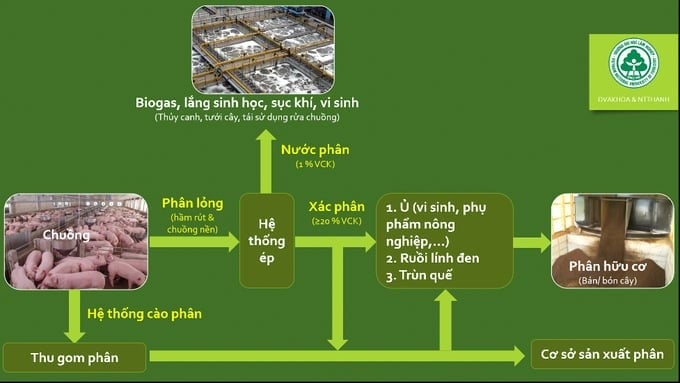
Solid waste treatment model.
Pig farming has been entering the second livestock industrial revolution, requiring professionalism, standards, quality, etc. to ensure healthy and fierce competition in the domestic market and imported products.
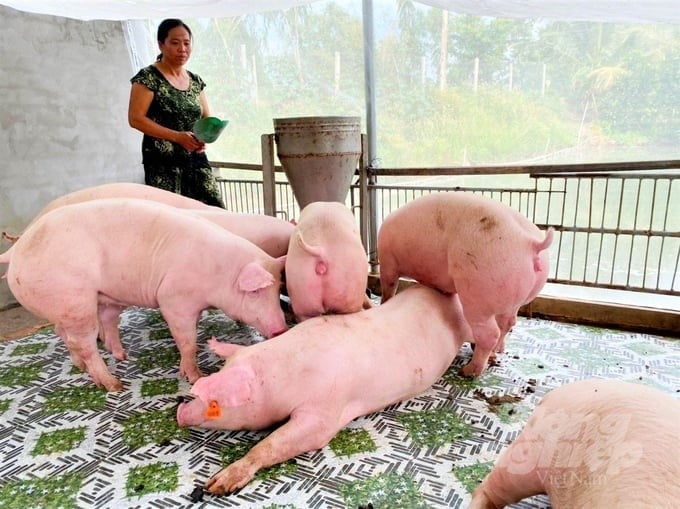
Pig farming has entered the second livestock industrial revolution, requiring professionalism, standards, and quality. Photo: TL.
Therefore, new technologies that help increase product value and improve livestock efficiency (reducing labor, improving biosecurity, etc.) must be applied, especially to chain livestock systems (seed – feed – pre-processing/processing, etc.) that have been gradually formed or completed in the very near future.
New technology is also a challenge for small and medium livestock producers (investment costs, operating costs, new people, etc.). Therefore, appropriate and timely directions, policies, and support are needed, and small and medium livestock producers should proactively connect and participate in chains to optimize technology investment costs.
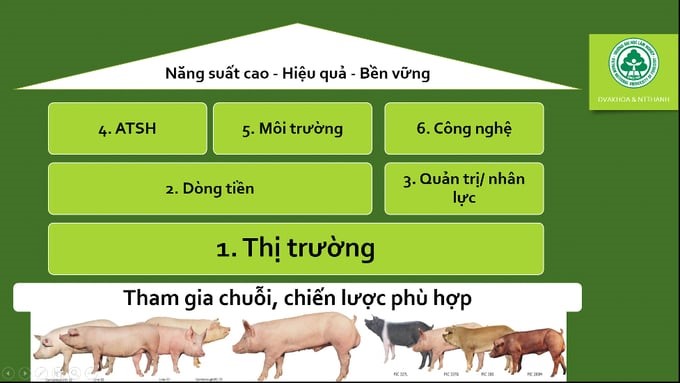
Regardless of the technology, before thinking about investing in pig farming in the second industrial race, it is necessary to ensure the following factors: (i) market (in order to expand, investing in the market is the most important), (ii) cash flow (to sustain the economy in general and the unstable livestock economy in particular), (iii) high-quality human resources (to meet the requirements for management or administration of large, high-tech farm systems in which future livestock engineers and veterinarians can be high-level workers), (iv) biosecurity (to withstand the current ASF epidemic storm and new diseases or variations of old diseases), and (v) a clean environment. Individual farmers and small-medium enterprises must have appropriate strategies and should participate in the value chain with large companies.
It should be reminded that not all new technology can be applied effectively to Vietnam’s livestock farming conditions when the human factor is not professional or comprehensive.
Group of Authors: Assoc. Prof. Dr. Do Vo Anh Khoa, Assoc. Prof. Dr. Pham Kim Dang, Assoc. Prof. Dr. Nguyen Van Duc, Dr. Nguyen Tien Thanh, and Dr. Nguyen Tuyet Giang
Translated by Huyen Vu Thu

(VAN) Seafood by-products are opening a new path, combining green growth and technological innovation to enhance the industry's value.

(VAN) Mr. Nguyen Thanh Cong, Vice Chairman of the Son La Provincial People's Committee, reflects on Son La’s journey from barren hills to fruitful orchards after a decade of hard work.
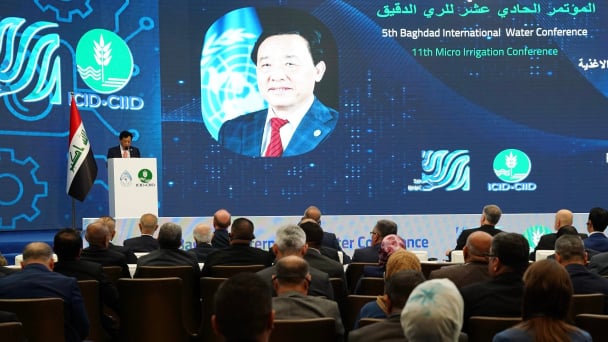
(VAN) FAO’s Director-General addresses the 5th Baghdad International Water Conference.
/2025/05/26/1716-4-nongnghiep-191706.jpg)
(VAN) Chain linkages, technological innovation, and raw material zoning are three strategic pillars for the coconut industry to strongly develop and elevate its position on the global agricultural map.
![Advanced mariculture – an inevitable trend: [4] Accompanied by scientists](https://t.ex-cdn.com/nongnghiepmoitruong.vn/608w/files/sohk/2025/05/13/1941-pgsts-vo-van-nha-140958_717.jpg)
(VAN) According to Assoc. Prof. Dr. Vo Van Nha, Director of the RIA III, the development of advanced offshore mariculture is no longer an option but an essential path for Vietnam’s fisheries sector.

(VAN) Vietnam is intensifying the development of mollusk farming areas that meet international standards, aiming for sustainable growth and enhancing its export position in the global seafood market.
![Advanced mariculture – an inevitable trend: [3] Policy-driven momentum](https://t.ex-cdn.com/nongnghiepmoitruong.vn/608w/files/doanhtq/2025/05/21/0104-0616-0348-nuoi-bien-170339_789.jpg)
(VAN) To ensure the success of offshore mariculture that uses advanced technologies, it is essential to establish supportive policies that inspire both individuals and enterprises to invest with confidence.